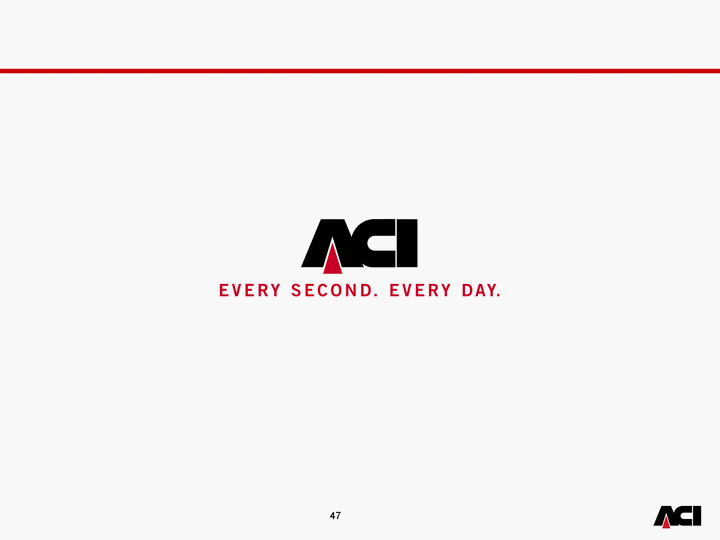Attached files
| file | filename |
|---|---|
| 8-K - FORM 8-K - ACI WORLDWIDE, INC. | c56542e8vk.htm |
| EX-99.1 - EX-99.1 - ACI WORLDWIDE, INC. | c56542exv99w1.htm |
Exhibit 99.2
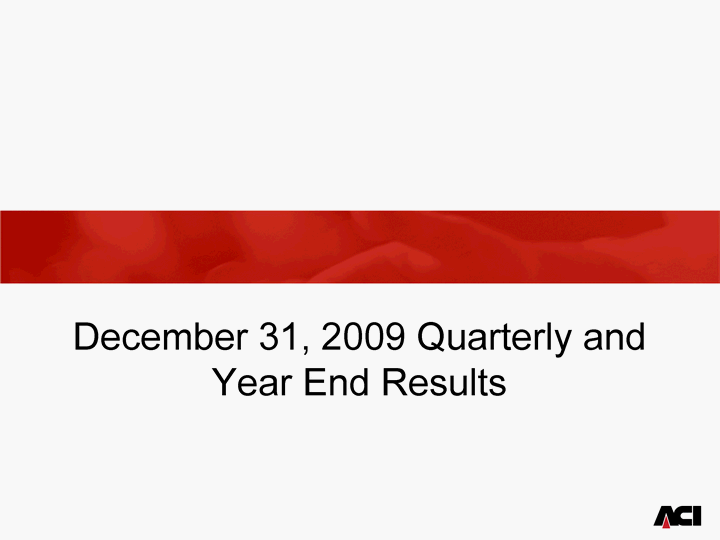
| December 31, 2009 Quarterly and Year End Results |
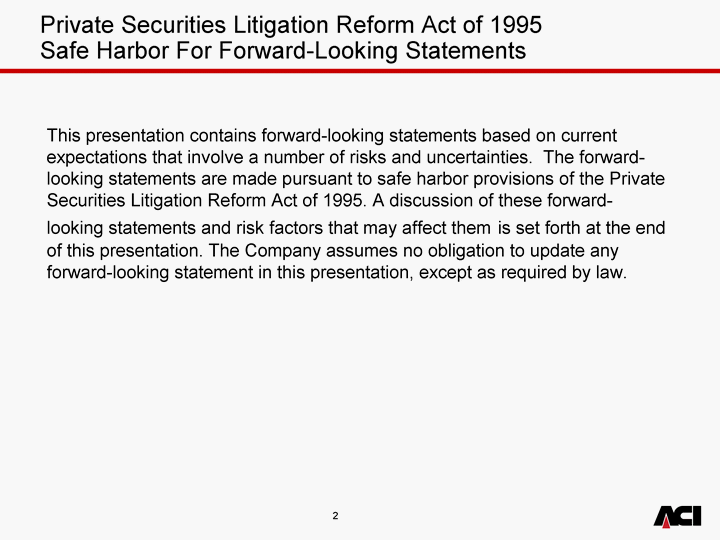
| This presentation contains forward-looking statements based on current expectations that involve a number of risks and uncertainties. The forward- looking statements are made pursuant to safe harbor provisions of the Private Securities Litigation Reform Act of 1995. A discussion of these forward- looking statements and risk factors that may affect them is set forth at the end of this presentation. The Company assumes no obligation to update any forward-looking statement in this presentation, except as required by law. Private Securities Litigation Reform Act of 1995 Safe Harbor For Forward-Looking Statements |
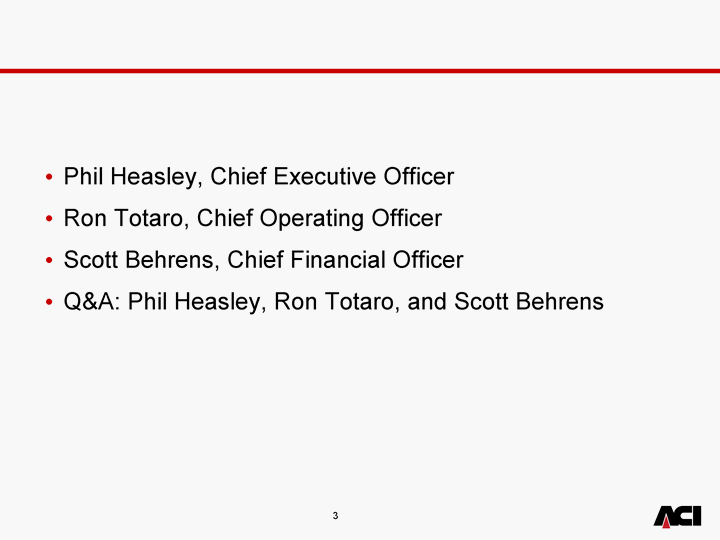
| Phil Heasley, Chief Executive Officer Ron Totaro, Chief Operating Officer Scott Behrens, Chief Financial Officer Q&A: Phil Heasley, Ron Totaro, and Scott Behrens Agenda |
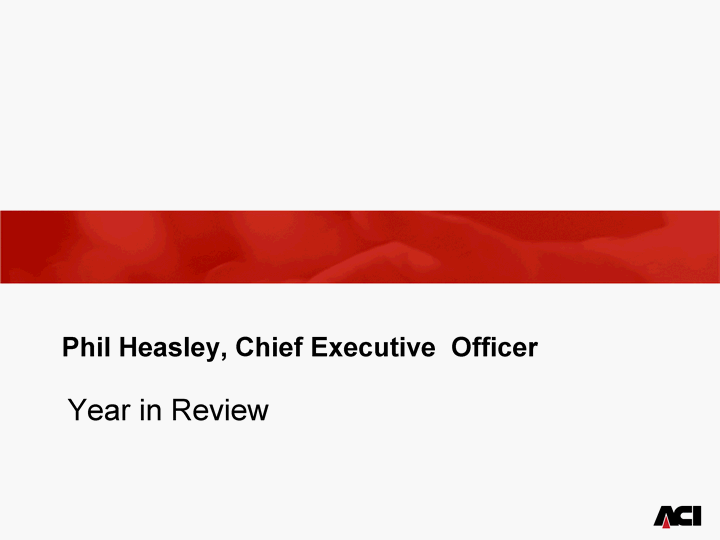
| Phil Heasley, Chief Executive Officer Year in Review |
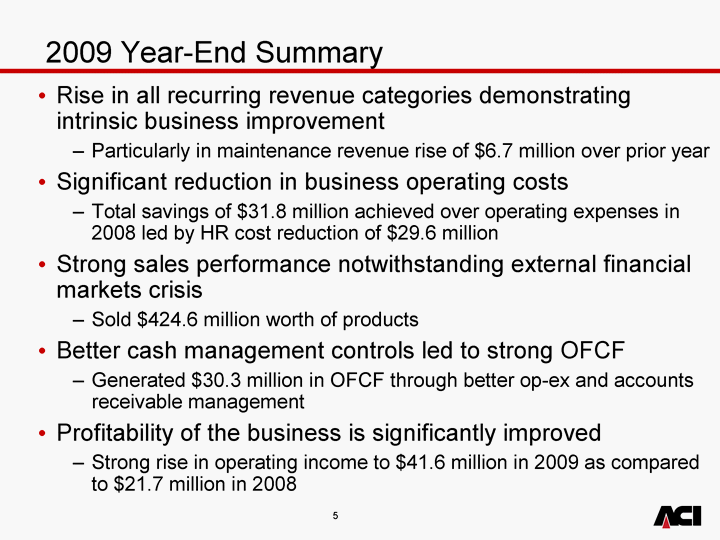
| 2009 Year-End Summary Rise in all recurring revenue categories demonstrating intrinsic business improvement Particularly in maintenance revenue rise of $6.7 million over prior year Significant reduction in business operating costs Total savings of $31.8 million achieved over operating expenses in 2008 led by HR cost reduction of $29.6 million Strong sales performance notwithstanding external financial markets crisis Sold $424.6 million worth of products Better cash management controls led to strong OFCF Generated $30.3 million in OFCF through better op-ex and accounts receivable management Profitability of the business is significantly improved Strong rise in operating income to $41.6 million in 2009 as compared to $21.7 million in 2008 |
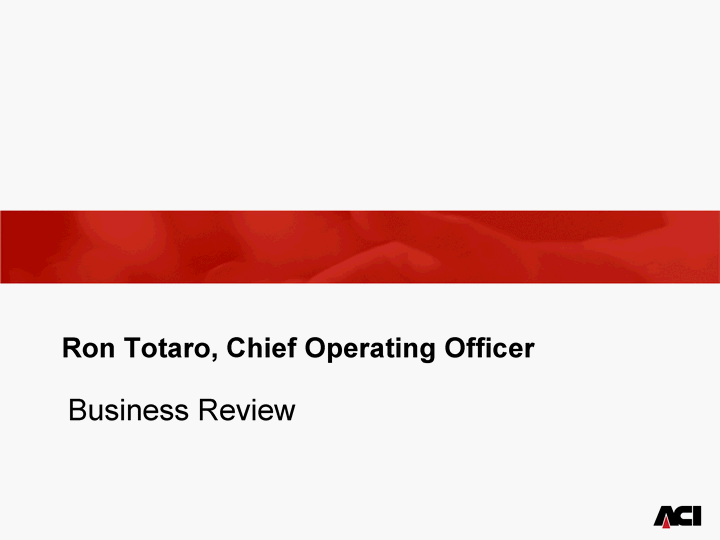
| Ron Totaro, Chief Operating Officer Business Review |
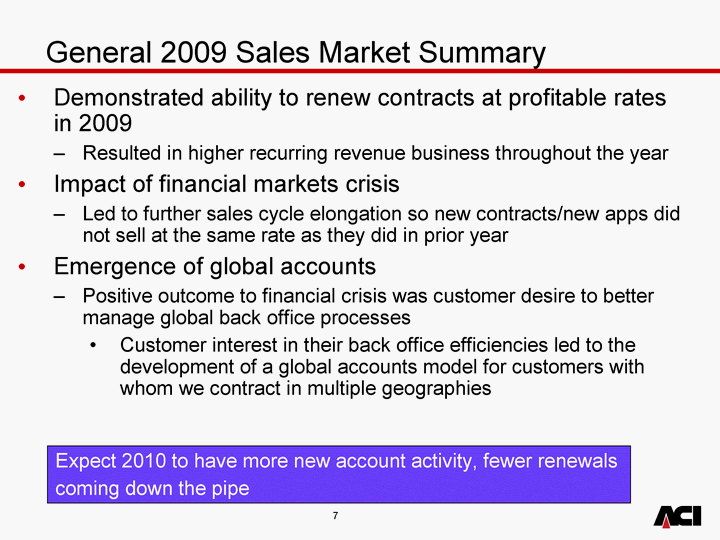
| General 2009 Sales Market Summary Demonstrated ability to renew contracts at profitable rates in 2009 Resulted in higher recurring revenue business throughout the year Impact of financial markets crisis Led to further sales cycle elongation so new contracts/new apps did not sell at the same rate as they did in prior year Emergence of global accounts Positive outcome to financial crisis was customer desire to better manage global back office processes Customer interest in their back office efficiencies led to the development of a global accounts model for customers with whom we contract in multiple geographies Expect 2010 to have more new account activity, fewer renewals coming down the pipe |
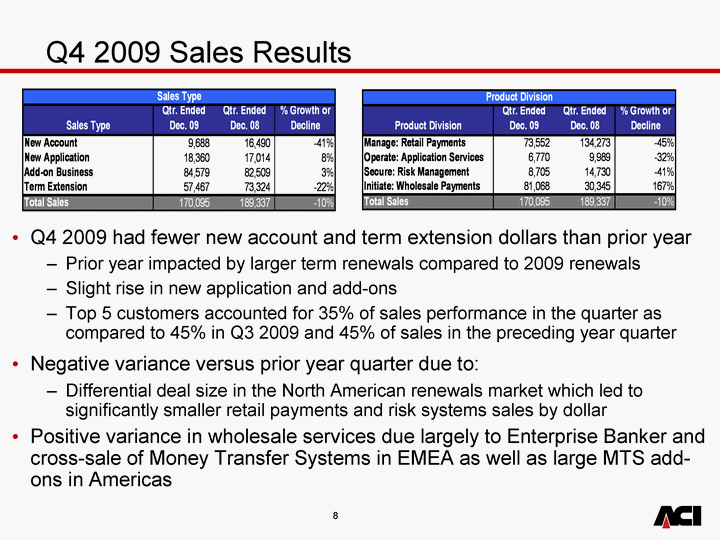
| Q4 2009 Sales Results Q4 2009 had fewer new account and term extension dollars than prior year Prior year impacted by larger term renewals compared to 2009 renewals Slight rise in new application and add-ons Top 5 customers accounted for 35% of sales performance in the quarter as compared to 45% in Q3 2009 and 45% of sales in the preceding year quarter Negative variance versus prior year quarter due to: Differential deal size in the North American renewals market which led to significantly smaller retail payments and risk systems sales by dollar Positive variance in wholesale services due largely to Enterprise Banker and cross-sale of Money Transfer Systems in EMEA as well as large MTS add- ons in Americas ons in Americas ons in Americas ons in Americas ons in Americas ons in Americas ons in Americas ons in Americas ons in Americas ons in Americas ons in Americas ons in Americas ons in Americas ons in Americas ons in Americas ons in Americas ons in Americas ons in Americas ons in Americas ons in Americas ons in Americas ons in Americas ons in Americas |
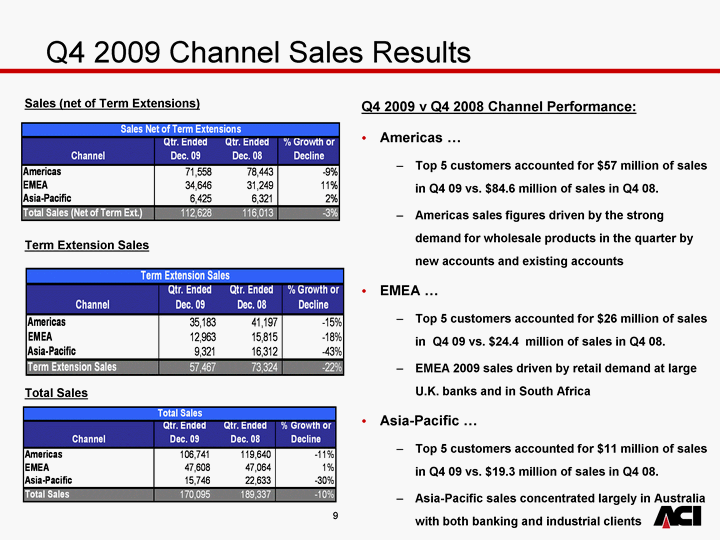
| Q4 2009 Channel Sales Results Sales (net of Term Extensions) Term Extension Sales Total Sales Q4 2009 v Q4 2008 Channel Performance: Americas ... Top 5 customers accounted for $57 million of sales in Q4 09 vs. $84.6 million of sales in Q4 08. Americas sales figures driven by the strong demand for wholesale products in the quarter by new accounts and existing accounts EMEA ... Top 5 customers accounted for $26 million of sales in Q4 09 vs. $24.4 million of sales in Q4 08. EMEA 2009 sales driven by retail demand at large U.K. banks and in South Africa Asia-Pacific ... Top 5 customers accounted for $11 million of sales in Q4 09 vs. $19.3 million of sales in Q4 08. Asia-Pacific sales concentrated largely in Australia with both banking and industrial clients with both banking and industrial clients with both banking and industrial clients with both banking and industrial clients with both banking and industrial clients with both banking and industrial clients with both banking and industrial clients with both banking and industrial clients with both banking and industrial clients with both banking and industrial clients with both banking and industrial clients with both banking and industrial clients with both banking and industrial clients with both banking and industrial clients with both banking and industrial clients with both banking and industrial clients with both banking and industrial clients with both banking and industrial clients with both banking and industrial clients with both banking and industrial clients with both banking and industrial clients with both banking and industrial clients with both banking and industrial clients with both banking and industrial clients with both banking and industrial clients with both banking and industrial clients with both banking and industrial clients with both banking and industrial clients with both banking and industrial clients with both banking and industrial clients with both banking and industrial clients with both banking and industrial clients with both banking and industrial clients with both banking and industrial clients with both banking and industrial clients with both banking and industrial clients with both banking and industrial clients with both banking and industrial clients with both banking and industrial clients with both banking and industrial clients with both banking and industrial clients with both banking and industrial clients with both banking and industrial clients with both banking and industrial clients with both banking and industrial clients with both banking and industrial clients with both banking and industrial clients with both banking and industrial clients with both banking and industrial clients with both banking and industrial clients with both banking and industrial clients with both banking and industrial clients |
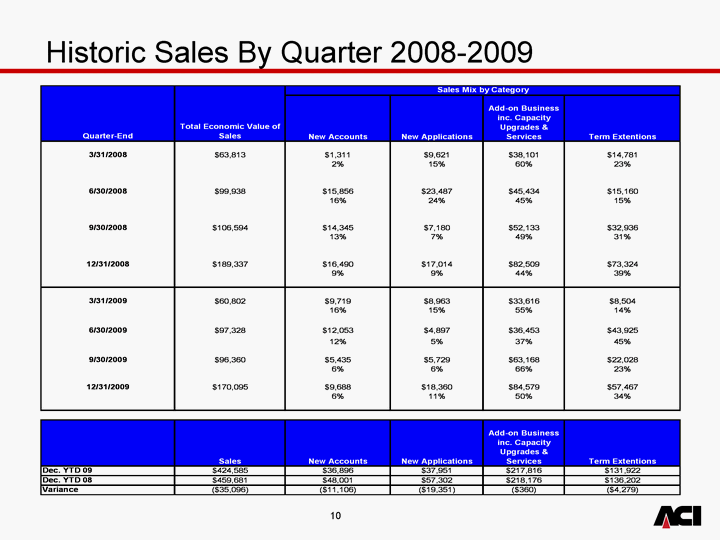
| Historic Sales By Quarter 2008-2009 Historic Sales By Quarter 2008-2009 |
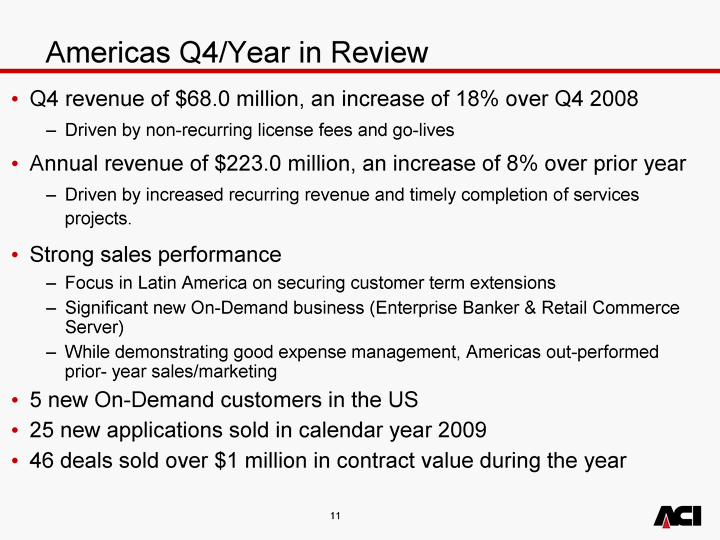
| Americas Q4/Year in Review Q4 revenue of $68.0 million, an increase of 18% over Q4 2008 Driven by non-recurring license fees and go-lives Annual revenue of $223.0 million, an increase of 8% over prior year Driven by increased recurring revenue and timely completion of services projects. Strong sales performance Focus in Latin America on securing customer term extensions Significant new On-Demand business (Enterprise Banker & Retail Commerce Server) While demonstrating good expense management, Americas out-performed prior- year sales/marketing 5 new On-Demand customers in the US 25 new applications sold in calendar year 2009 46 deals sold over $1 million in contract value during the year |
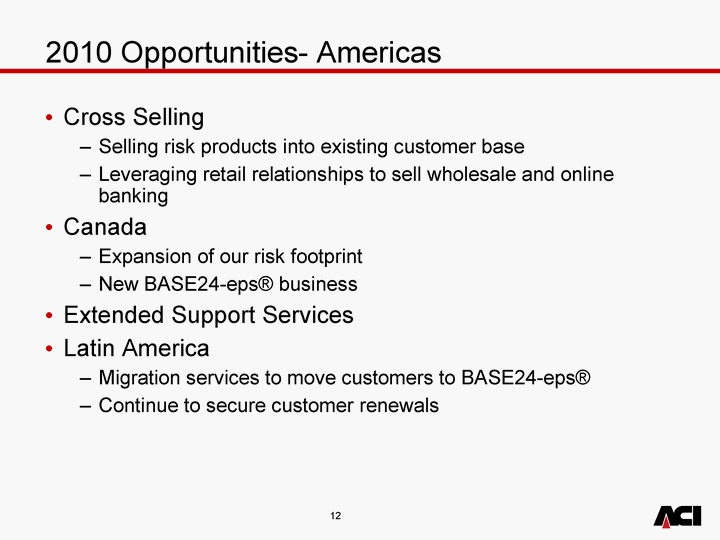
| 2010 Opportunities- Americas Cross Selling Selling risk products into existing customer base Leveraging retail relationships to sell wholesale and online banking Canada Expansion of our risk footprint New BASE24-eps(r) business Extended Support Services Latin America Migration services to move customers to BASE24-eps(r) Continue to secure customer renewals |
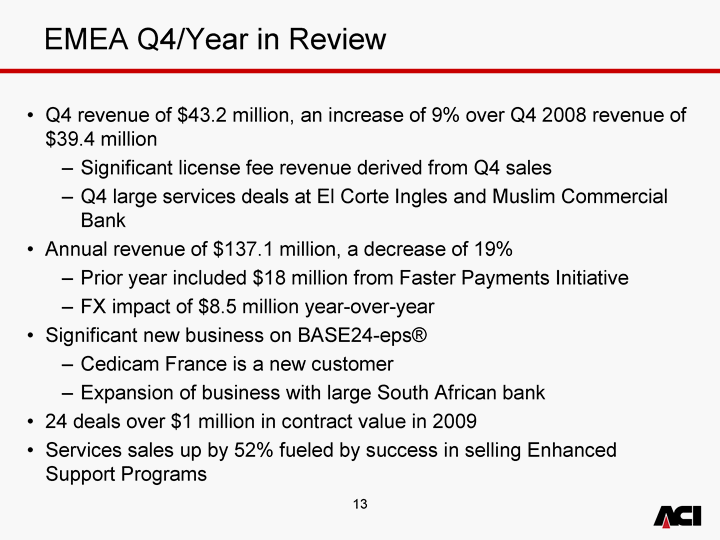
| EMEA Q4/Year in Review Q4 revenue of $43.2 million, an increase of 9% over Q4 2008 revenue of $39.4 million Significant license fee revenue derived from Q4 sales Q4 large services deals at El Corte Ingles and Muslim Commercial Bank Annual revenue of $137.1 million, a decrease of 19% Prior year included $18 million from Faster Payments Initiative FX impact of $8.5 million year-over-year Significant new business on BASE24-eps(r) Cedicam France is a new customer Expansion of business with large South African bank 24 deals over $1 million in contract value in 2009 Services sales up by 52% fueled by success in selling Enhanced Support Programs 13 |
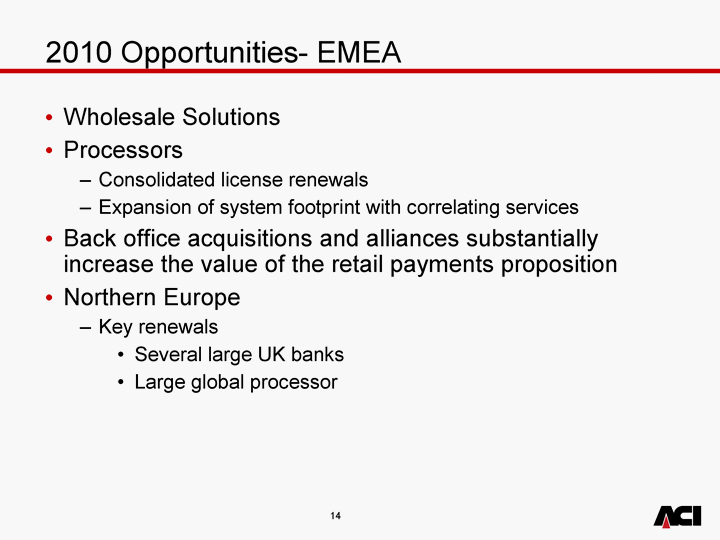
| 2010 Opportunities- EMEA Wholesale Solutions Processors Consolidated license renewals Expansion of system footprint with correlating services Back office acquisitions and alliances substantially increase the value of the retail payments proposition Northern Europe Key renewals Several large UK banks Large global processor |
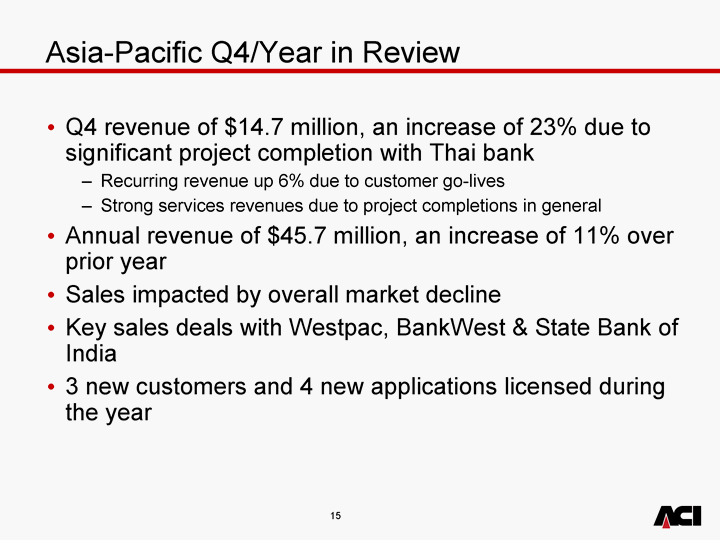
| Asia-Pacific Q4/Year in Review Q4 revenue of $14.7 million, an increase of 23% due to significant project completion with Thai bank Recurring revenue up 6% due to customer go-lives Strong services revenues due to project completions in general Annual revenue of $45.7 million, an increase of 11% over prior year Sales impacted by overall market decline Key sales deals with Westpac, BankWest & State Bank of India 3 new customers and 4 new applications licensed during the year |
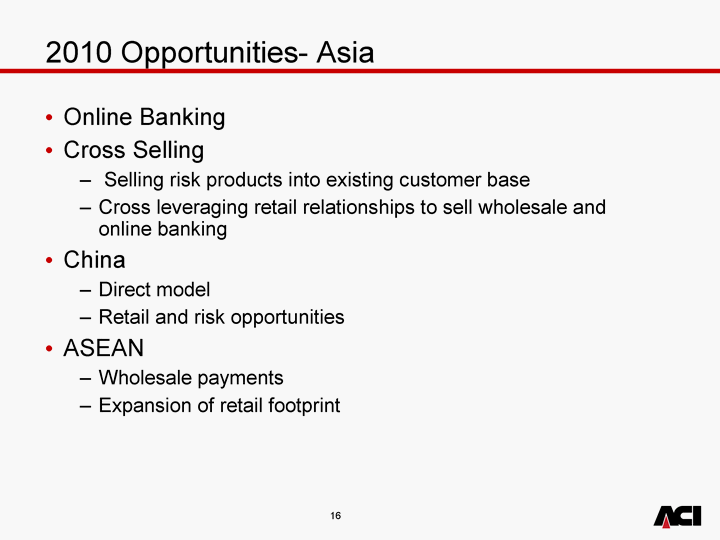
| 2010 Opportunities- Asia Online Banking Cross Selling Selling risk products into existing customer base Cross leveraging retail relationships to sell wholesale and online banking China Direct model Retail and risk opportunities ASEAN Wholesale payments Expansion of retail footprint |
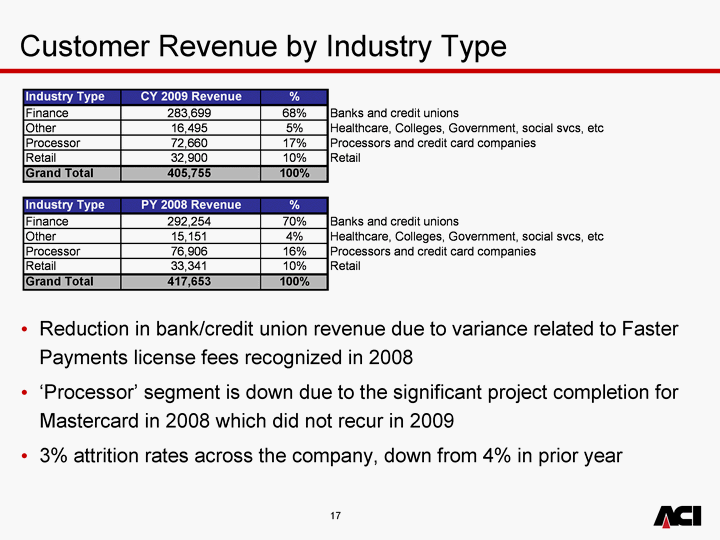
| Customer Revenue by Industry Type Reduction in bank/credit union revenue due to variance related to Faster Payments license fees recognized in 2008 'Processor' segment is down due to the significant project completion for Mastercard in 2008 which did not recur in 2009 3% attrition rates across the company, down from 4% in prior year |
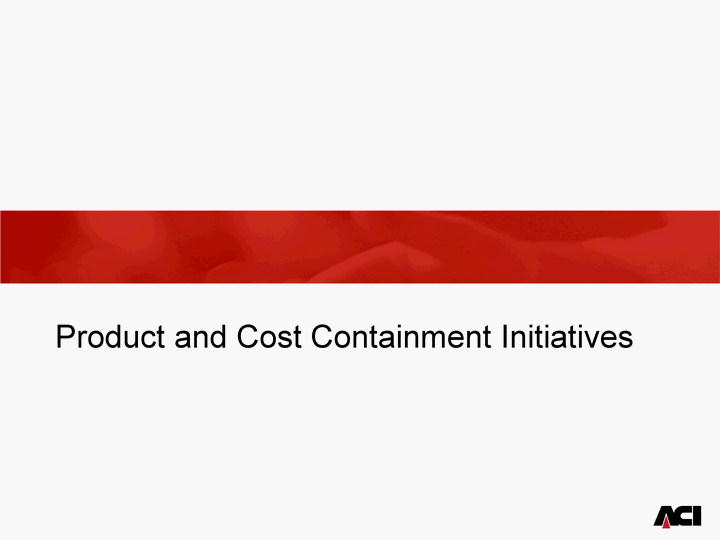
| Product and Cost Containment Initiatives |
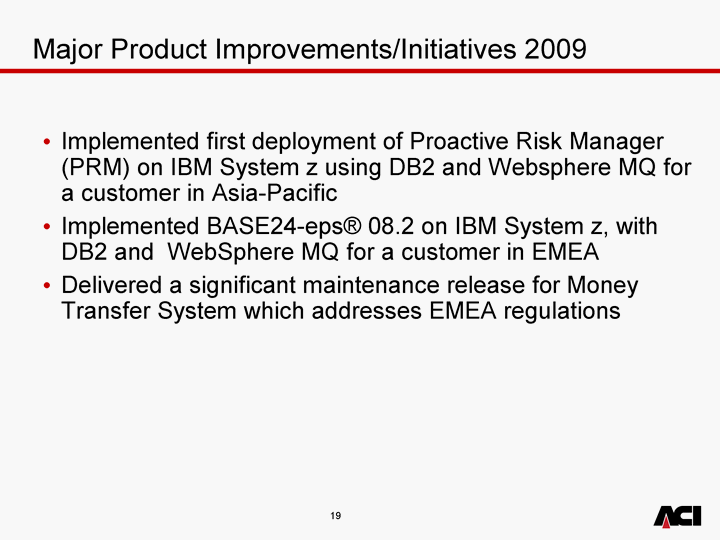
| Major Product Improvements/Initiatives 2009 Implemented first deployment of Proactive Risk Manager (PRM) on IBM System z using DB2 and Websphere MQ for a customer in Asia-Pacific Implemented BASE24-eps(r) 08.2 on IBM System z, with DB2 and WebSphere MQ for a customer in EMEA Delivered a significant maintenance release for Money Transfer System which addresses EMEA regulations |
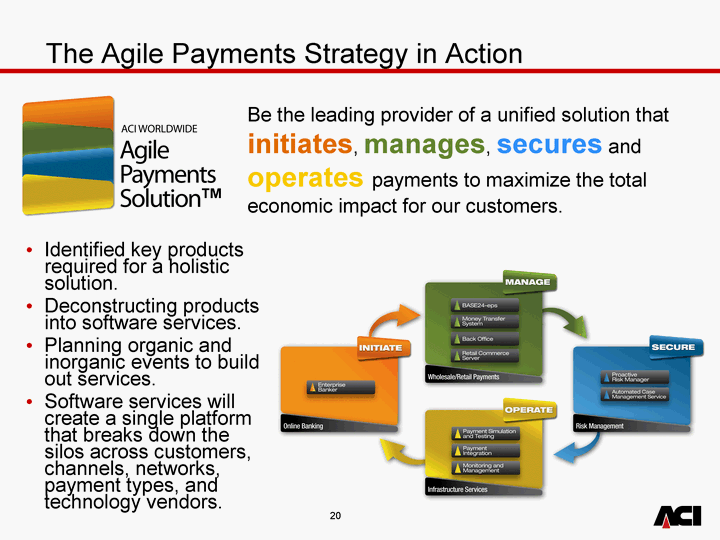
| The Agile Payments Strategy in Action Be the leading provider of a unified solution that initiates, manages, secures and operates payments to maximize the total economic impact for our customers. Identified key products required for a holistic solution. Deconstructing products into software services. Planning organic and inorganic events to build out services. Software services will create a single platform that breaks down the silos across customers, channels, networks, payment types, and technology vendors. (tm) |
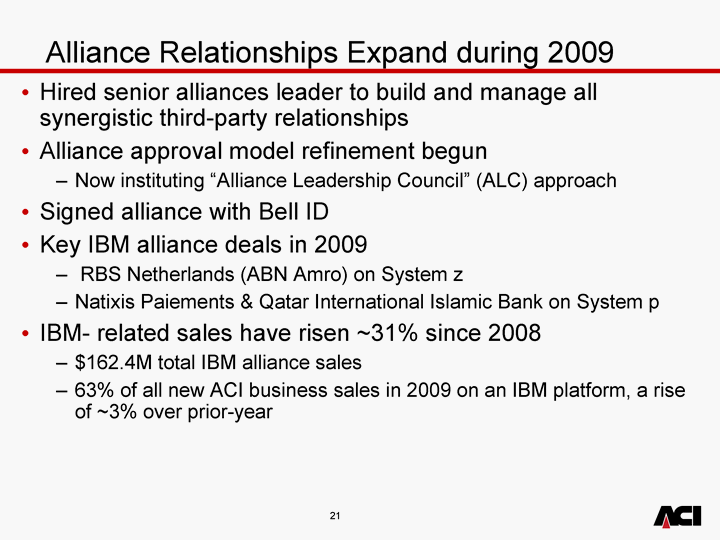
| Alliance Relationships Expand during 2009 Hired senior alliances leader to build and manage all synergistic third-party relationships Alliance approval model refinement begun Now instituting "Alliance Leadership Council" (ALC) approach Signed alliance with Bell ID Key IBM alliance deals in 2009 RBS Netherlands (ABN Amro) on System z Natixis Paiements & Qatar International Islamic Bank on System p IBM- related sales have risen ~31% since 2008 $162.4M total IBM alliance sales 63% of all new ACI business sales in 2009 on an IBM platform, a rise of ~3% over prior-year |

| Business Improvement Achievements in 2009 Rationalized headcount in mature markets and reinvested in growth regions Hired chief product officer, services leaders in EMEA and Asia as well as new EMEA sales leader Globalized Help24 customer support Purchased selected, strategic products and engineered alliances (Essentis and Bell ID) Cost containment of $31.8 million achieved overall |
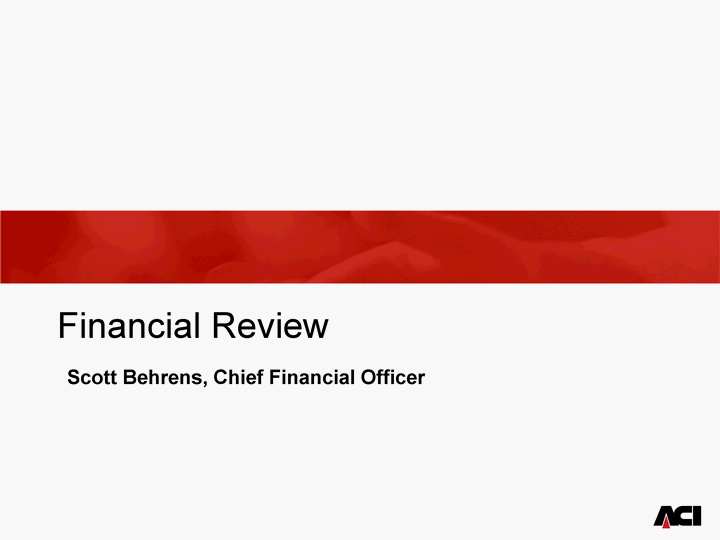
| Financial Review Scott Behrens, Chief Financial Officer |
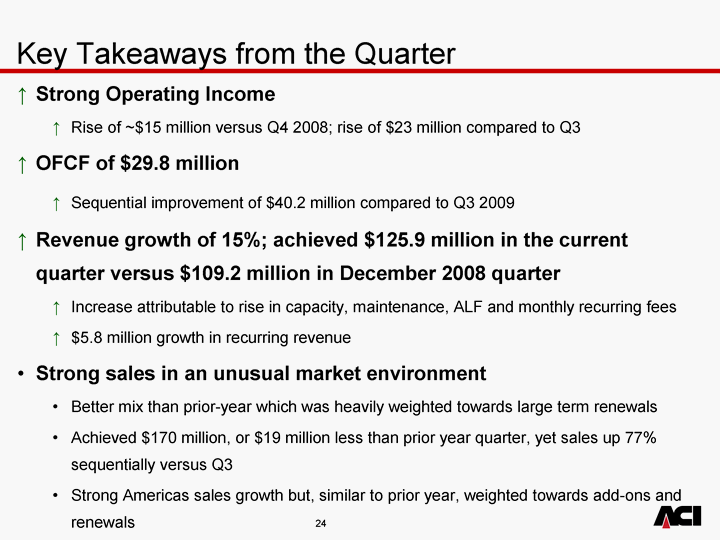
| Key Takeaways from the Quarter Strong Operating Income Rise of ~$15 million versus Q4 2008; rise of $23 million compared to Q3 OFCF of $29.8 million Sequential improvement of $40.2 million compared to Q3 2009 Revenue growth of 15%; achieved $125.9 million in the current quarter versus $109.2 million in December 2008 quarter Increase attributable to rise in capacity, maintenance, ALF and monthly recurring fees $5.8 million growth in recurring revenue Strong sales in an unusual market environment Better mix than prior-year which was heavily weighted towards large term renewals Achieved $170 million, or $19 million less than prior year quarter, yet sales up 77% sequentially versus Q3 Strong Americas sales growth but, similar to prior year, weighted towards add-ons and renewals 24 |
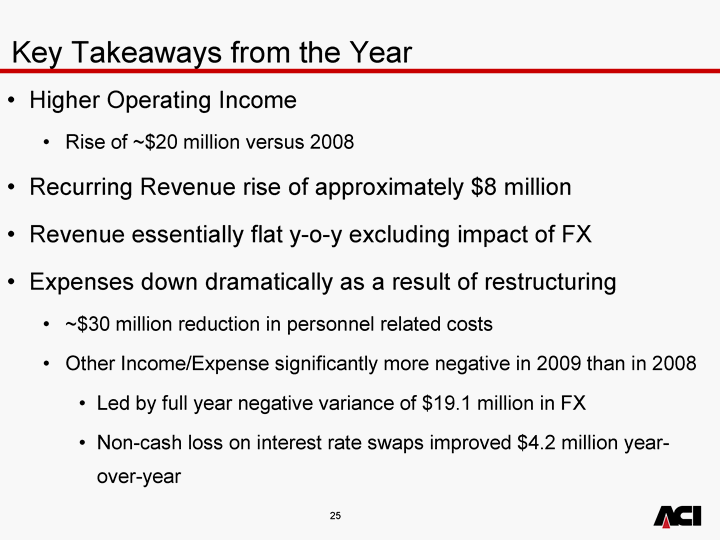
| Key Takeaways from the Year Higher Operating Income Rise of ~$20 million versus 2008 Recurring Revenue rise of approximately $8 million Revenue essentially flat y-o-y excluding impact of FX Expenses down dramatically as a result of restructuring ~$30 million reduction in personnel related costs Other Income/Expense significantly more negative in 2009 than in 2008 Led by full year negative variance of $19.1 million in FX Non-cash loss on interest rate swaps improved $4.2 million year- over-year |
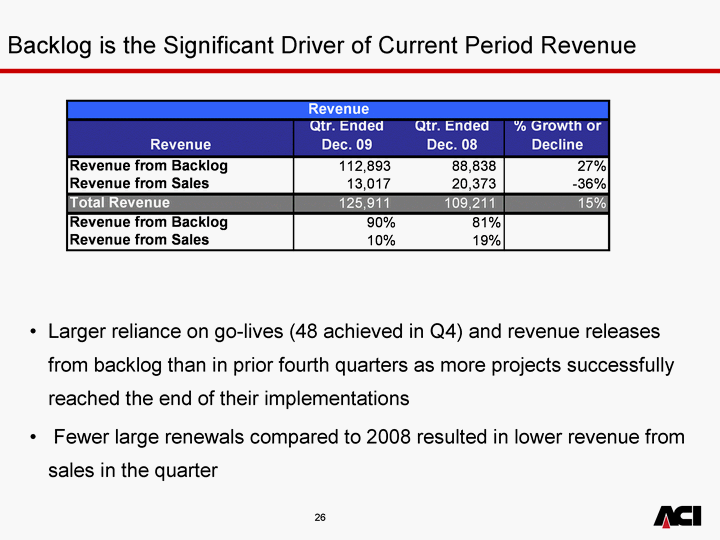
| Backlog is the Significant Driver of Current Period Revenue Larger reliance on go-lives (48 achieved in Q4) and revenue releases from backlog than in prior fourth quarters as more projects successfully reached the end of their implementations Fewer large renewals compared to 2008 resulted in lower revenue from sales in the quarter Fewer large renewals compared to 2008 resulted in lower revenue from sales in the quarter Fewer large renewals compared to 2008 resulted in lower revenue from sales in the quarter Fewer large renewals compared to 2008 resulted in lower revenue from sales in the quarter 26 |
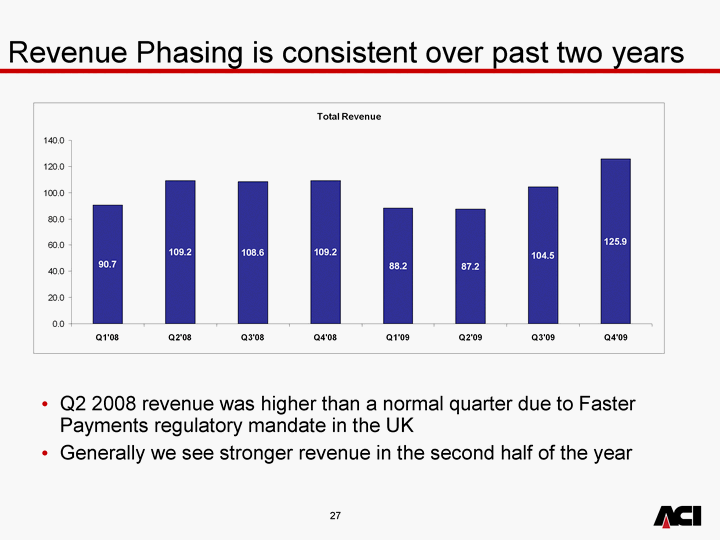
| Revenue Phasing is consistent over past two years Revenue Phasing is consistent over past two years Q2 2008 revenue was higher than a normal quarter due to Faster Payments regulatory mandate in the UK Generally we see stronger revenue in the second half of the year |
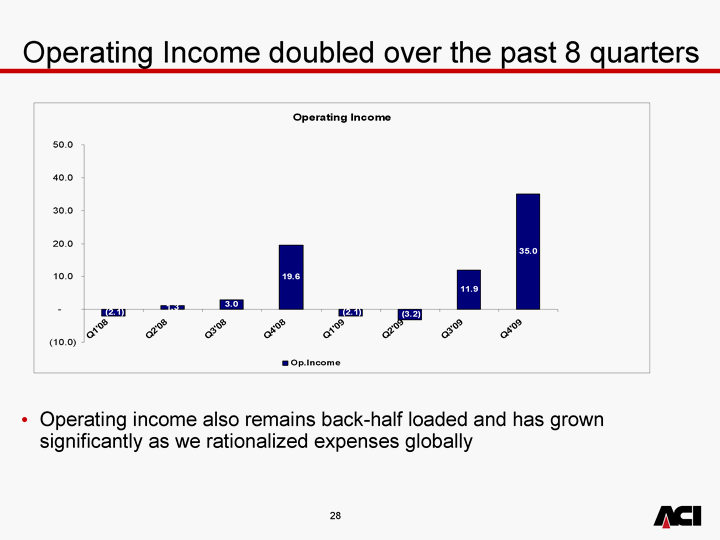
| Operating Income doubled over the past 8 quarters Operating income also remains back-half loaded and has grown significantly as we rationalized expenses globally significantly as we rationalized expenses globally significantly as we rationalized expenses globally |
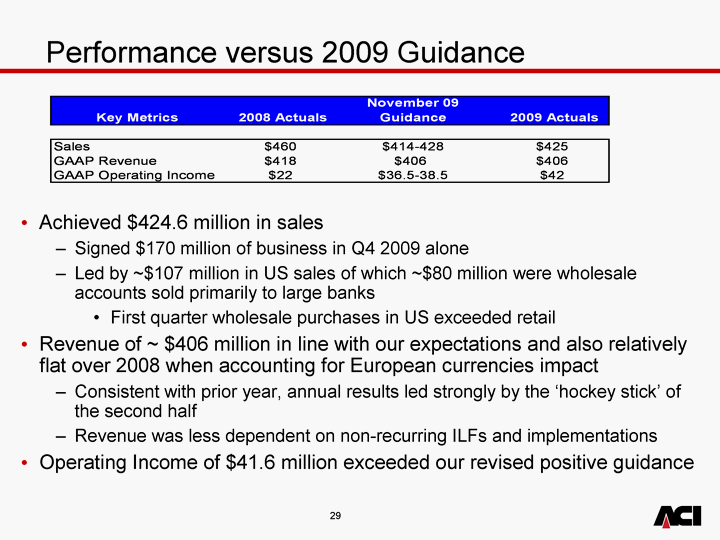
| Performance versus 2009 Guidance Achieved $424.6 million in sales Signed $170 million of business in Q4 2009 alone Led by ~$107 million in US sales of which ~$80 million were wholesale accounts sold primarily to large banks First quarter wholesale purchases in US exceeded retail Revenue of ~ $406 million in line with our expectations and also relatively flat over 2008 when accounting for European currencies impact Consistent with prior year, annual results led strongly by the 'hockey stick' of the second half Revenue was less dependent on non-recurring ILFs and implementations Operating Income of $41.6 million exceeded our revised positive guidance Operating Income of $41.6 million exceeded our revised positive guidance Operating Income of $41.6 million exceeded our revised positive guidance Operating Income of $41.6 million exceeded our revised positive guidance Operating Income of $41.6 million exceeded our revised positive guidance Operating Income of $41.6 million exceeded our revised positive guidance Operating Income of $41.6 million exceeded our revised positive guidance Operating Income of $41.6 million exceeded our revised positive guidance Operating Income of $41.6 million exceeded our revised positive guidance Operating Income of $41.6 million exceeded our revised positive guidance Operating Income of $41.6 million exceeded our revised positive guidance Operating Income of $41.6 million exceeded our revised positive guidance |
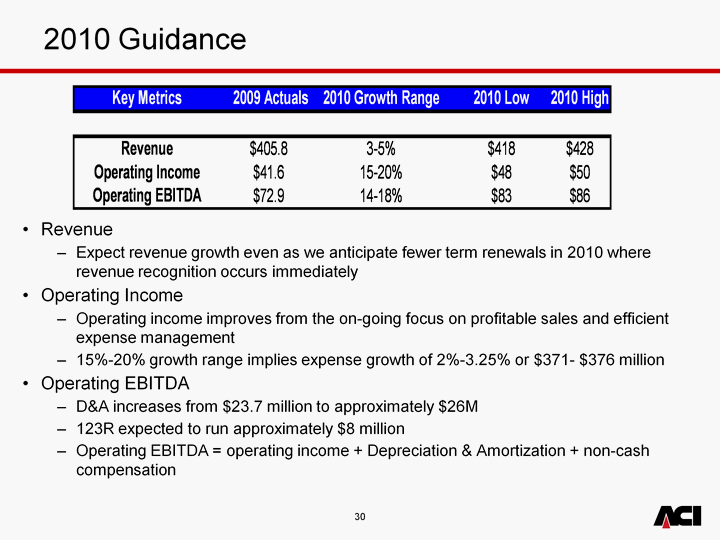
| 2010 Guidance Revenue Expect revenue growth even as we anticipate fewer term renewals in 2010 where revenue recognition occurs immediately Operating Income Operating income improves from the on-going focus on profitable sales and efficient expense management 15%-20% growth range implies expense growth of 2%-3.25% or $371- $376 million Operating EBITDA D&A increases from $23.7 million to approximately $26M 123R expected to run approximately the same as 2009 at $7.6 million Operating EBITDA = operating income + Depreciation & Amortization + non- cash compensation cash compensation cash compensation cash compensation cash compensation cash compensation cash compensation cash compensation cash compensation cash compensation cash compensation cash compensation cash compensation cash compensation |
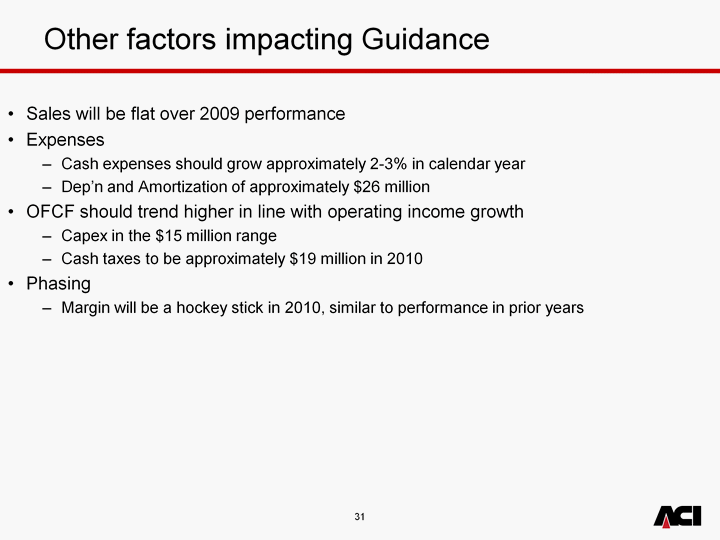
| Other factors impacting Guidance Sales will be flat over 2009 performance Expenses Cash expenses should grow approximately 2-3% in calendar year Dep'n and Amortization of approximately $26 million Non Cash compensation expense of approximately $7-8 million OFCF should trend higher in line with operating income growth Capex in the $15 million range Cash taxes to be approximately $19 million in 2010 Phasing Margin will be a hockey stick in 2010, similar to performance in prior years |
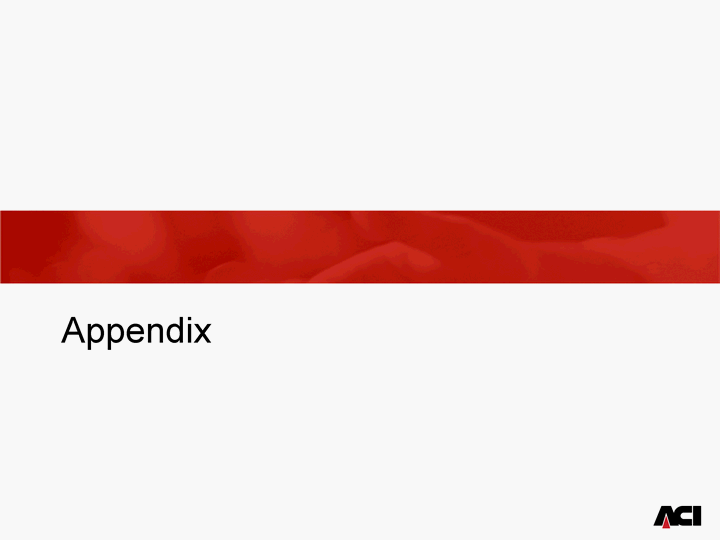
| Appendix |
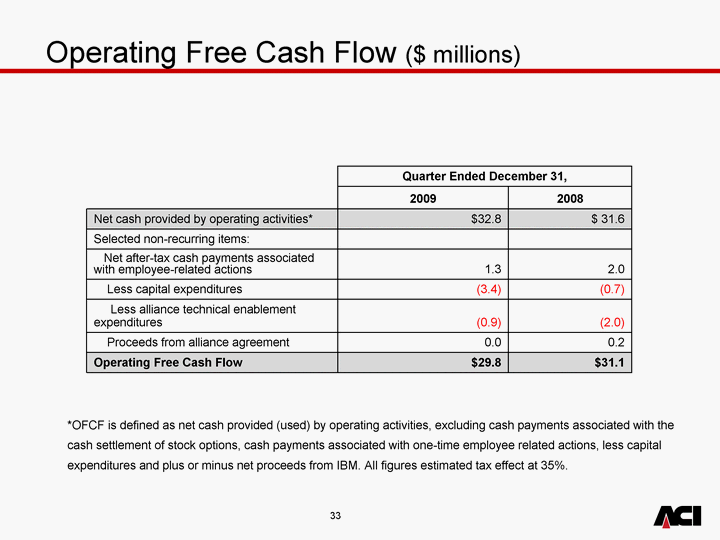
| Operating Free Cash Flow ($ millions) Quarter Ended December 31, Quarter Ended December 31, 2009 2008 Net cash provided by operating activities* $32.8 $ 31.6 Selected non-recurring items: Net after-tax cash payments associated with employee-related actions 1.3 2.0 Less capital expenditures (3.4) (0.7) Less alliance technical enablement expenditures (0.9) (2.0) Proceeds from alliance agreement 0.0 0.2 Operating Free Cash Flow $29.8 $31.1 *OFCF is defined as net cash provided (used) by operating activities, excluding cash payments associated with the cash settlement of stock options, cash payments associated with one-time employee related actions, less capital expenditures and plus or minus net proceeds from IBM. All figures estimated tax effect at 35%. |
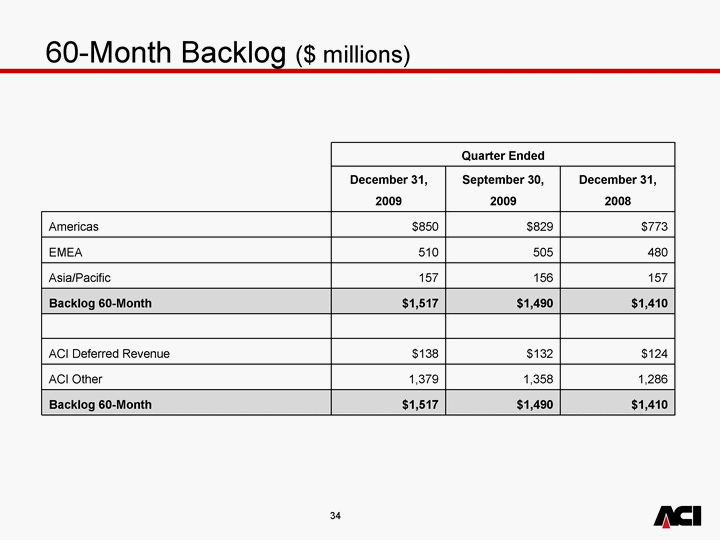
| 60-Month Backlog ($ millions) Quarter Ended Quarter Ended Quarter Ended December 31, September 30, December 31, 2009 2009 2008 Americas $850 $829 $773 EMEA 510 505 480 Asia/Pacific 157 156 157 Backlog 60-Month $1,517 $1,490 $1,410 ACI Deferred Revenue $138 $132 $124 ACI Other 1,379 1,358 1,286 Backlog 60-Month $1,517 $1,490 $1,410 |
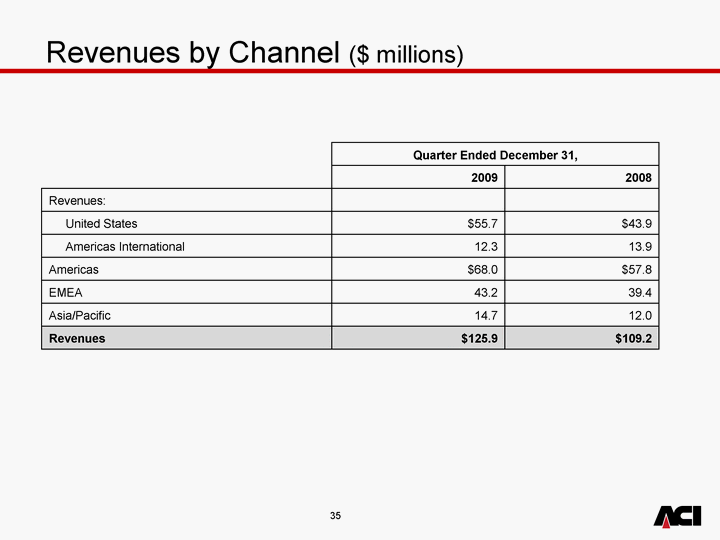
| Revenues by Channel ($ millions) Quarter Ended December 31, Quarter Ended December 31, 2009 2008 Revenues: United States $55.7 $43.9 Americas International 12.3 13.9 Americas $68.0 $57.8 EMEA 43.2 39.4 Asia/Pacific 14.7 12.0 Revenues $125.9 $109.2 |
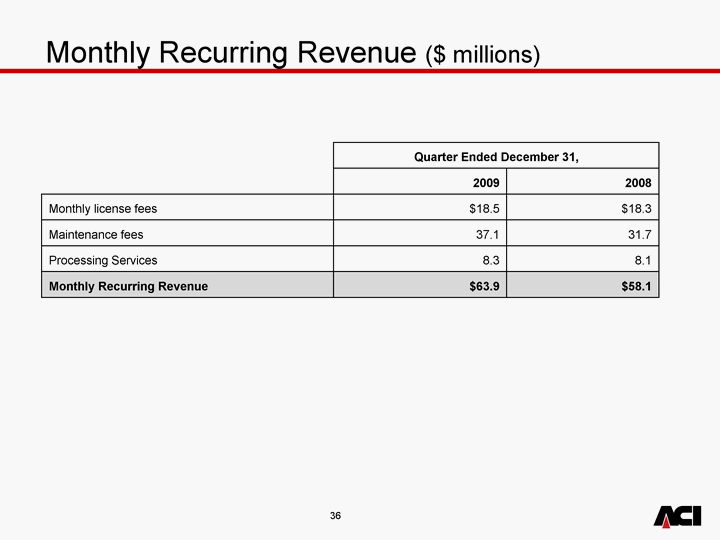
| Monthly Recurring Revenue ($ millions) Quarter Ended December 31, Quarter Ended December 31, 2009 2008 Monthly license fees $18.5 $18.3 Maintenance fees 37.1 31.7 Processing Services 8.3 8.1 Monthly Recurring Revenue $63.9 $58.1 |
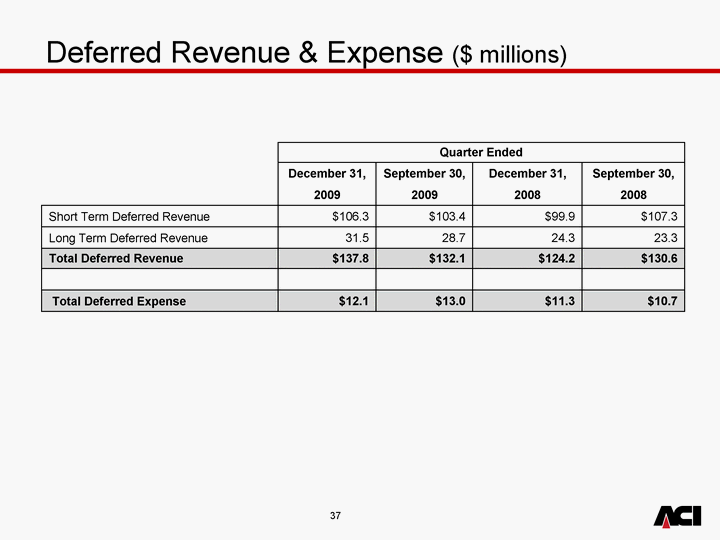
| Deferred Revenue & Expense ($ millions) Quarter Ended Quarter Ended Quarter Ended Quarter Ended December 31, September 30, December 31, September 30, 2009 2009 2008 2008 Short Term Deferred Revenue $106.3 $103.4 $99.9 $107.3 Long Term Deferred Revenue 31.5 28.7 24.3 23.3 Total Deferred Revenue $137.8 $132.1 $124.2 $130.6 Total Deferred Expense $12.1 $13.0 $11.3 $10.7 |
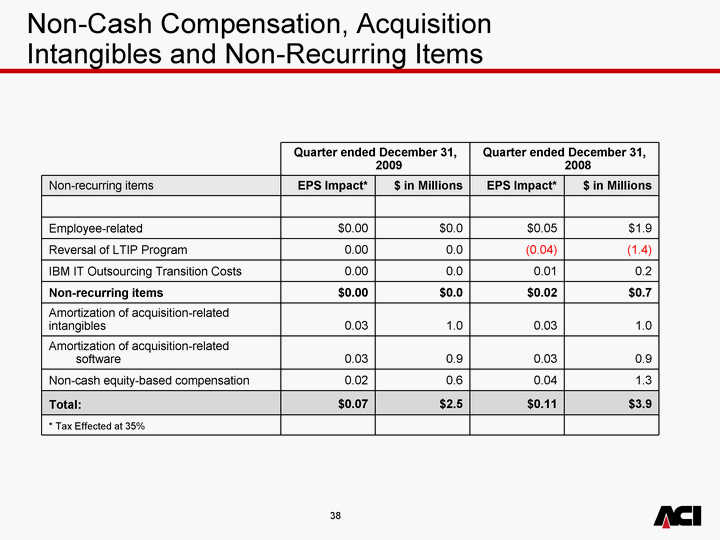
| Non-Cash Compensation, Acquisition Intangibles and Non-Recurring Items Quarter ended December 31, 2009 Quarter ended December 31, 2009 Quarter ended December 31, 2008 Quarter ended December 31, 2008 Non-recurring items EPS Impact* $ in Millions EPS Impact* $ in Millions Employee-related $0.00 $0.0 $0.05 $1.9 Reversal of LTIP Program 0.00 0.0 (0.04) (1.4) IBM IT Outsourcing Transition Costs 0.00 0.0 0.01 0.2 Non-recurring items $0.00 $0.0 $0.02 $0.7 Amortization of acquisition-related intangibles 0.03 1.0 0.03 1.0 Amortization of acquisition-related software 0.03 0.9 0.03 0.9 Non-cash equity-based compensation 0.02 0.6 0.04 1.3 Total: $0.07 $2.5 $0.11 $3.9 * Tax Effected at 35% |
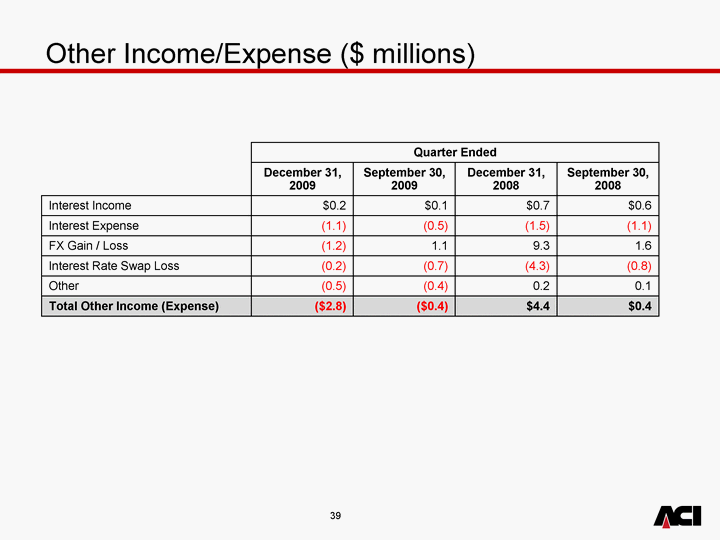
| Other Income/Expense ($ millions) Quarter Ended Quarter Ended Quarter Ended Quarter Ended December 31, 2009 September 30, 2009 December 31, 2008 September 30, 2008 Interest Income $0.2 $0.1 $0.7 $0.6 Interest Expense (1.1) (0.5) (1.5) (1.1) FX Gain / Loss (1.2) 1.1 9.3 1.6 Interest Rate Swap Loss (0.2) (0.7) (4.3) (0.8) Other (0.5) (0.4) 0.2 0.1 Total Other Income (Expense) ($2.8) ($0.4) $4.4 $0.4 |
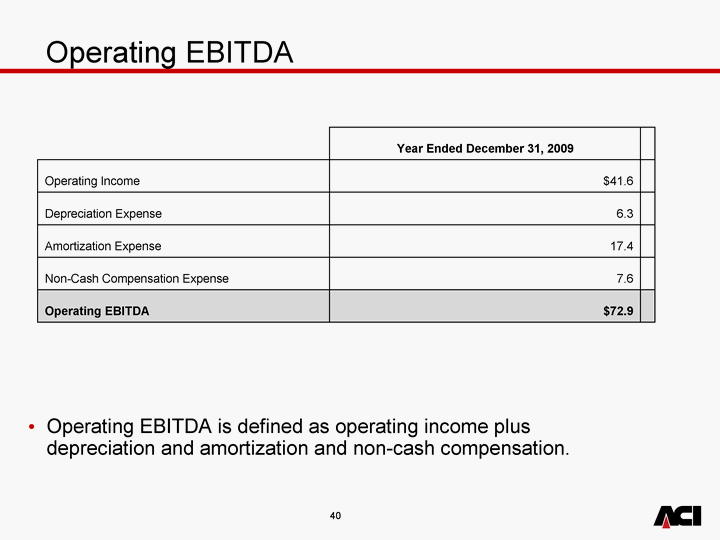
| Operating EBITDA Year Ended December 31, 2009 Operating Income $41.6 Depreciation Expense 6.3 Amortization Expense 17.4 Non-Cash Compensation Expense 7.6 Operating EBITDA $72.9 Operating EBITDA is defined as operating income plus depreciation and amortization and non-cash compensation. |
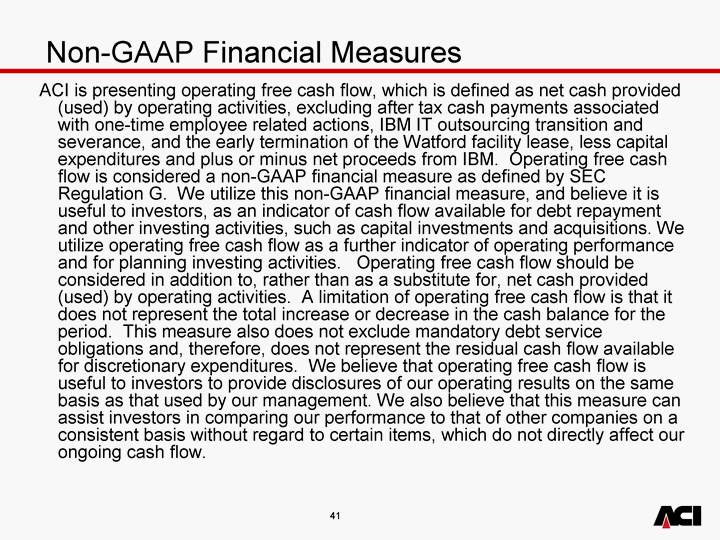
| Non-GAAP Financial Measures ACI is presenting operating free cash flow, which is defined as net cash provided (used) by operating activities, excluding after tax cash payments associated with one-time employee related actions, IBM IT outsourcing transition and severance, and the early termination of the Watford facility lease, less capital expenditures and plus or minus net proceeds from IBM. Operating free cash flow is considered a non-GAAP financial measure as defined by SEC Regulation G. We utilize this non-GAAP financial measure, and believe it is useful to investors, as an indicator of cash flow available for debt repayment and other investing activities, such as capital investments and acquisitions. We utilize operating free cash flow as a further indicator of operating performance and for planning investing activities. Operating free cash flow should be considered in addition to, rather than as a substitute for, net cash provided (used) by operating activities. A limitation of operating free cash flow is that it does not represent the total increase or decrease in the cash balance for the period. This measure also does not exclude mandatory debt service obligations and, therefore, does not represent the residual cash flow available for discretionary expenditures. We believe that operating free cash flow is useful to investors to provide disclosures of our operating results on the same basis as that used by our management. We also believe that this measure can assist investors in comparing our performance to that of other companies on a consistent basis without regard to certain items, which do not directly affect our ongoing cash flow. |
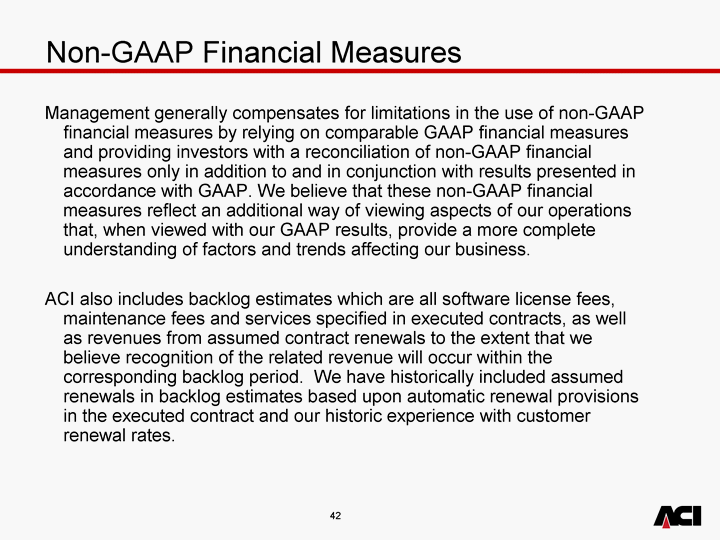
| Non-GAAP Financial Measures Management generally compensates for limitations in the use of non-GAAP financial measures by relying on comparable GAAP financial measures and providing investors with a reconciliation of non-GAAP financial measures only in addition to and in conjunction with results presented in accordance with GAAP. We believe that these non-GAAP financial measures reflect an additional way of viewing aspects of our operations that, when viewed with our GAAP results, provide a more complete understanding of factors and trends affecting our business. ACI also includes backlog estimates which are all software license fees, maintenance fees and services specified in executed contracts, as well as revenues from assumed contract renewals to the extent that we believe recognition of the related revenue will occur within the corresponding backlog period. We have historically included assumed renewals in backlog estimates based upon automatic renewal provisions in the executed contract and our historic experience with customer renewal rates. |
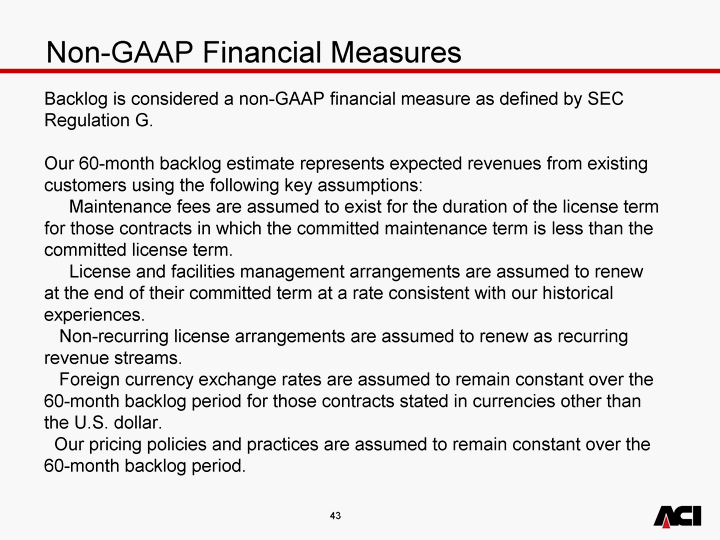
| Non-GAAP Financial Measures Backlog is considered a non-GAAP financial measure as defined by SEC Regulation G. Our 60-month backlog estimate represents expected revenues from existing customers using the following key assumptions: Maintenance fees are assumed to exist for the duration of the license term for those contracts in which the committed maintenance term is less than the committed license term. License and facilities management arrangements are assumed to renew at the end of their committed term at a rate consistent with our historical experiences. Non-recurring license arrangements are assumed to renew as recurring revenue streams. Foreign currency exchange rates are assumed to remain constant over the 60-month backlog period for those contracts stated in currencies other than the U.S. dollar. Our pricing policies and practices are assumed to remain constant over the 60-month backlog period. |

| Non-GAAP Financial Measures Estimates of future financial results are inherently unreliable. Our backlog estimates require substantial judgment and are based on a number of assumptions as described above. These assumptions may turn out to be inaccurate or wrong, including for reasons outside of management's control. For example, our customers may attempt to renegotiate or terminate their contracts for a number of reasons, including mergers, changes in their financial condition, or general changes in economic conditions in the customer's industry or geographic location, or we may experience delays in the development or delivery of products or services specified in customer contracts which may cause the actual renewal rates and amounts to differ from historical experiences. Changes in foreign currency exchange rates may also impact the amount of revenue actually recognized in future periods. Accordingly, there can be no assurance that contracts included in backlog estimates will actually generate the specified revenues or that the actual revenues will be generated within the corresponding 60-month period. Backlog should be considered in addition to, rather than as a substitute for, reported revenue and deferred revenue. The presentation of these non-GAAP financial measures should be considered in addition to our GAAP results and is not intended to be considered in isolation or as a substitute for the financial information prepared and presented in accordance with GAAP. |
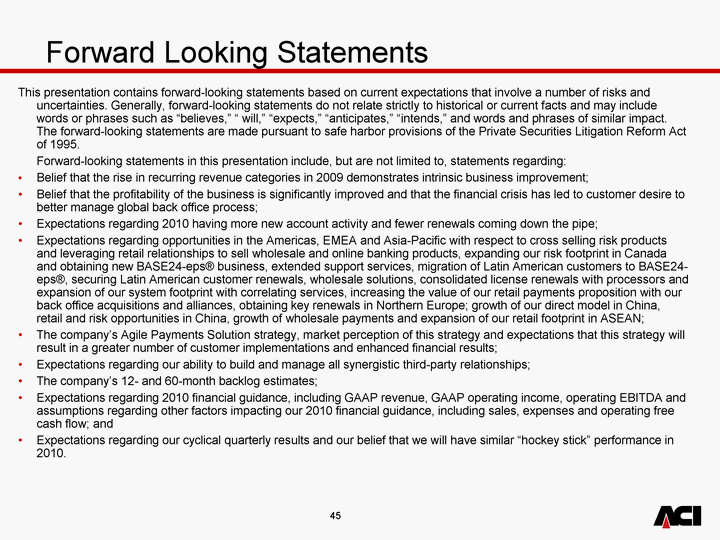
| Forward Looking Statements This presentation contains forward-looking statements based on current expectations that involve a number of risks and uncertainties. Generally, forward-looking statements do not relate strictly to historical or current facts and may include words or phrases such as "believes," " will," "expects," "anticipates," "intends," and words and phrases of similar impact. The forward-looking statements are made pursuant to safe harbor provisions of the Private Securities Litigation Reform Act of 1995. Forward-looking statements in this presentation include, but are not limited to, statements regarding: Belief that the rise in recurring revenue categories in 2009 demonstrates intrinsic business improvement; Belief that the profitability of the business is significantly improved and that the financial crisis has led to customer desire to better manage global back office process; Expectations regarding 2010 having more new account activity and fewer renewals coming down the pipe; Expectations regarding opportunities in the Americas, EMEA and Asia-Pacific with respect to cross selling risk products and leveraging retail relationships to sell wholesale and online banking products, expanding our risk footprint in Canada and obtaining new BASE24-eps(r) business, extended support services, migration of Latin American customers to BASE24- eps(r), securing Latin American customer renewals, wholesale solutions, consolidated license renewals with processors and expansion of our system footprint with correlating services, increasing the value of our retail payments proposition with our back office acquisitions and alliances, obtaining key renewals in Northern Europe; growth of our direct model in China, retail and risk opportunities in China, growth of wholesale payments and expansion of our retail footprint in ASEAN; The company's Agile Payments Solution strategy, market perception of this strategy and expectations that this strategy will result in a greater number of customer implementations and enhanced financial results; Expectations regarding our ability to build and manage all synergistic third-party relationships; The company's 12- and 60-month backlog estimates; Expectations regarding 2010 financial guidance, including GAAP revenue, GAAP operating income, operating EBITDA and assumptions regarding other factors impacting our 2010 financial guidance, including sales, expenses and operating free cash flow; and Expectations regarding our cyclical quarterly results and our belief that we will have similar "hockey stick" performance in 2010. |
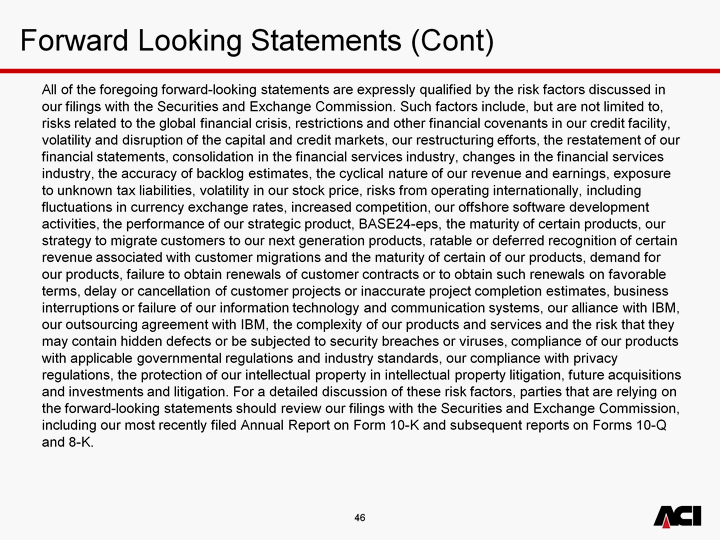
| Forward Looking Statements (Cont) All of the foregoing forward-looking statements are expressly qualified by the risk factors discussed in our filings with the Securities and Exchange Commission. Such factors include, but are not limited to, risks related to the global financial crisis, restrictions and other financial covenants in our credit facility, volatility and disruption of the capital and credit markets, our restructuring efforts, the restatement of our financial statements, consolidation in the financial services industry, changes in the financial services industry, the accuracy of backlog estimates, the cyclical nature of our revenue and earnings, exposure to unknown tax liabilities, volatility in our stock price, risks from operating internationally, including fluctuations in currency exchange rates, increased competition, our offshore software development activities, the performance of our strategic product, BASE24-eps, the maturity of certain products, our strategy to migrate customers to our next generation products, ratable or deferred recognition of certain revenue associated with customer migrations and the maturity of certain of our products, demand for our products, failure to obtain renewals of customer contracts or to obtain such renewals on favorable terms, delay or cancellation of customer projects or inaccurate project completion estimates, business interruptions or failure of our information technology and communication systems, our alliance with IBM, our outsourcing agreement with IBM, the complexity of our products and services and the risk that they may contain hidden defects or be subjected to security breaches or viruses, compliance of our products with applicable governmental regulations and industry standards, our compliance with privacy regulations, the protection of our intellectual property in intellectual property litigation, future acquisitions and investments and litigation. For a detailed discussion of these risk factors, parties that are relying on the forward-looking statements should review our filings with the Securities and Exchange Commission, including our most recently filed Annual Report on Form 10-K and subsequent reports on Forms 10-Q and 8-K. 46 |
